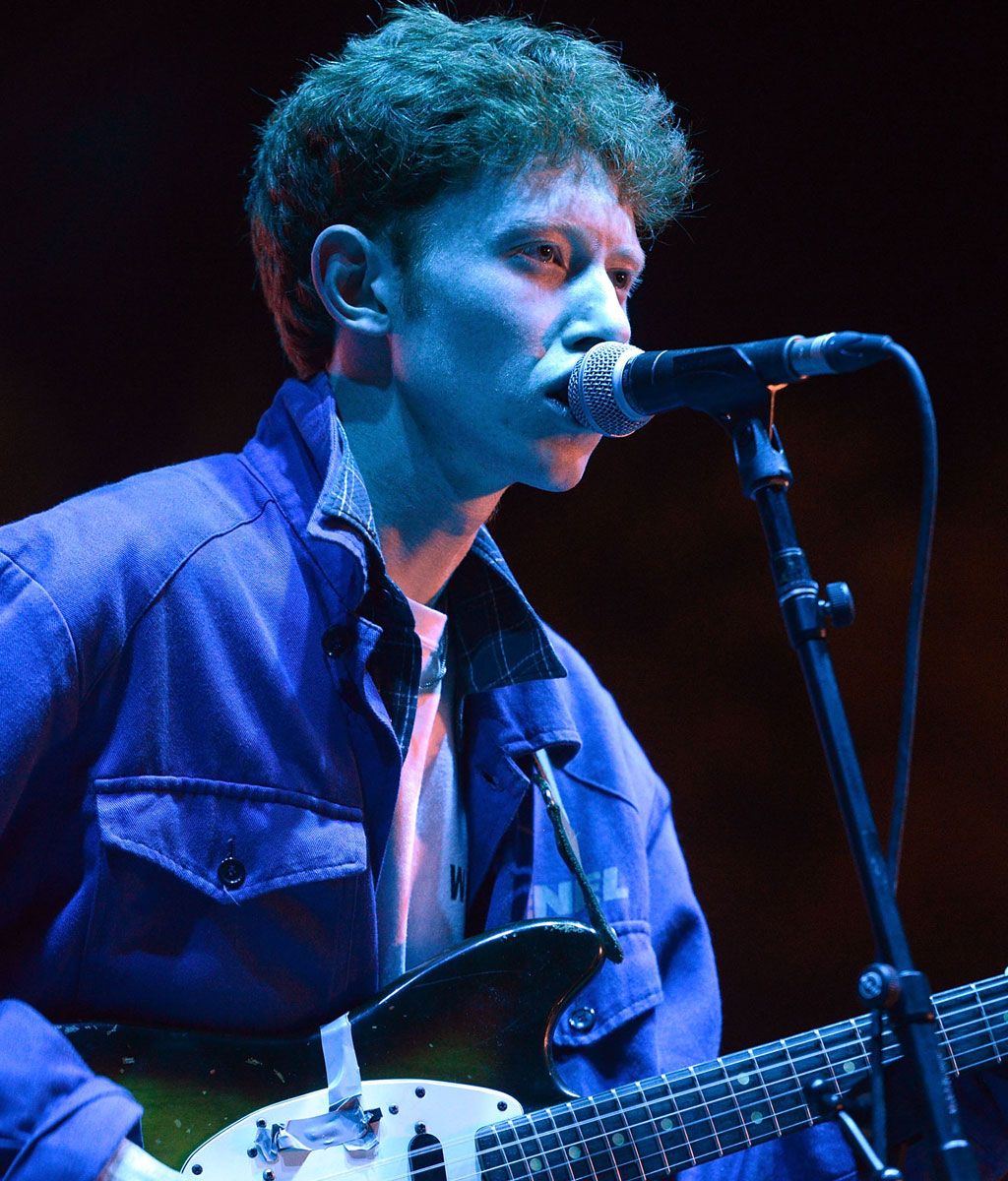Archy Marshall is feeling nauseous. It’s not because of the unseasonably warm September day and the rank smells that such heat releases from the concrete in Chinatown, but from a two-day battery of press interviews that he has already given and the pints that have accompanied them. Now Marshall finds before him not another pint glass but a shot of Pepto-Bismol, a substance he’s unfamiliar with back home in London. I equate it to pink slime.
“Pink Ooz!” his publicist quips, in reference to the record Marshall has released this past week under his more royal handle, King Krule. The Ooz has been long anticipated, coming seven years after Marshall first started garnering attention with songs posted online as Zoo Kid and four years after his debut 6 Feet Beneath the Moon made him a darling of genre-free folks into indie rock, gnashing New Wave, murky underground hip-hop, vintage alternative rock, and brooding, forlorn lounge jazz.
As Marshall swallows the pink stuff, he looses a bellowing groan, the telltale sound that punctuates many of his best songs. It’s a resonant, primal noise and an unexpected one at that, emanating as it does from Marshall’s slender, slouched build: the body of a piccolo with the timbre of a bassoon. That incongruity carries over to King Krule’s music as well, which sounds cocksure and despairing, tough and unguarded, seething and stoned, oft-times in the same song. “Being somewhat young, I felt like no one was giving us an edge, no one was being aggressive, no one was saying ‘fuck this shit’ around me,” he says of the conflicting emotions rumbling through his music. “I felt like that a lot.”
As indie rock’s cultural influence wanes, King Krule suggests a new path. “I have roots in indie,” he says, though he felt like the bands he saw when he was coming out were missing the point. “I was never about the clothes I was wearing. We’d go on tour and see bands in airports that looked like bands, all styled the same.”
King Krule is that rare 21st-century artist at home on almost any playlist, one who identifies as indie guitar music, but who also rubs shoulders with hip-hop and R&B. At a time when many new acts have trouble keeping an audience from one album to the next, King Krule’s fan base has waited patiently. His Spotify listeners still top 600,000 a month, and despite the one album to his name, his weekly sales figures put him in the same group of Beggars Group legacy acts like Queens of the Stone Age, Cat Power, and Interpol. Along the way, Marshall also made fans from the likes of Beyoncé and Sky Ferreira to Earl Sweatshirt and Ratking. And while a writing session with Frank Ocean didn’t quite pan out and he turned down the chance to work with Kanye West, Marshall recently made beats for Earl Sweatshirt and Wiki from Ratking. “Working with Earl was something that was really fucking natural,” he says. “The first day he got to my house, we spent four hours just jamming and smoking. Barely a word was spoken. It was that thing where you go, ‘Oh shit, there are kids exactly like me all across the world.’”
And yet for all of the youthful vigor, his follow-up almost didn’t happen. “There were moments when I didn’t have anything, I couldn’t work out anything,” he says of the cloud that overtook him in the years after 6 Feet Beneath the Moon. It wasn’t quite a writer’s block, as he still wrote daily, only, he says, “I wasn’t happy with any of it. I felt like I was lost for ages. I didn’t really know what I wanted to get out of music.”
Marshall said he had no issues making beats “in the box” — in fact, he boasts that he now has hours of jams that he can sample at will, his own personal sample library. But when it came time to pick up a guitar again and make music as King Krule, that magic touch was gone. “There were moments where — for someone like me — I doubt myself more than the normal person,” he says. That creative uncertainty lifted only when Marshall became romantically involved with a girl from Barcelona. (You can hear her speaking in Catalan about parasites and paradise on The Ooz’s “Bermondsey Bosom Pt 1.”) The relationship now ended, “I felt like I used her as a muse,” Marshall said of their dynamic.
Did she appreciate that role?
“Probably not. But she helped me. She was almost like a wall I could throw romantic shit at.” Around her, he played the guitar more, and slowly the creative juices unfroze and began to move again. That resultant breakthrough became The Ooz, King Krule’s 19-track opus, which over its run time documents Marshall’s many mind states. The title refers to bodily fluids — an in-joke between him and his older brother Jack — and that word has been deployed for numerous projects: They drew up their own comic books as Ooz Comics and also started a band called “Dik Ooz” (flipping the band name would give Marshall his first handle a few years on).
But The Ooz is also a deep dive into Marshall’s psyche, into the creative anguish of a young musician on the verge of being a major artist and throwing it all away. It posits Marshall as his generation’s most formidable stylist, veering into snarling punk, broken beat, wry romanticism, queasy ambience, surf noir, cool jazz, and beat-making with such assurance as to bridge the gap between indie bands and underground hip-hop, while at the same time being so unsure so as to speak to the most disaffected and despairing of listeners.
So a song like “Dum Surfer” veers easily from Marshall baldly calling a band “trash” and also thinking that, “if we were commuting, the train would fucking crash,” the title of the song switched out with the gentle reminder “don’t suffer.” The sound itself is as tricky as the emotions conveyed — “Dum Surfer” is a gnashing rocker that would have ruled MTV’s 120 Minutes a generation before, but with a saxophone line that snakes through it and dub effects twinkling at the periphery. It’s a dense rocker that turns out to be shifting sand.
Marshall remains a romantic at heart, garnering the smallest of details to paint intimate portraits. Against a curl of smoky saxophone on “Logos,” he details the end of that relationship: “I thought about her, her smell through clothes / Her spoken smoke, mixed with my cologne / We were soup together, but now it’s cold.” And a raw forlorn sadness encases his quivering voice on “Lonely Blue.” Throughout the album, allusions to that color and its many hues (in the sky and in the deep sea), abound. “I went overboard with that word and those allusions to prove that they’re mine and not anyone else’s,” Marshall admits. “It was kind of aggressive in a way. These are my metaphors, that’s in my universe, these are my words that I use. I guess it was a warning as well, a fuck-you to a lot of people trying to use my tonality and my metaphors.” Call it King Krule’s blue period. “My self-depreciation is big. My art, I never understood why people found it so fascinating. And that fascinates me.”
Yet he always trusted that he was going to be an artist. His grandfather and uncles all made their way as visual artists, Marshall calling their painting styles as “our own family style.” While his parents split at an early age, both were creative in their own endeavors. His father was an art director and played in a rock band. His seamstress mother had a giant portrait of Fela Kuti hanging over their dining-room table and Snoop Dogg’s face on a dress of her own design. Through his brother, he got into psychobilly bands like the Cramps and no wave, as well as the strange jazz John Lurie made with the Lounge Lizards.
Only recently has his father’s influence shone through. While on tour a few years ago, Marshall read his copy of Charles Bukowski’s coming-of-age book Ham on Rye, when he happened upon a journal in the middle of the book. “He speaks about sitting on this patch of grass in Peckham, the same bit of land where William Blake wrote about the angels in the trees. So my dad is sitting on this same patch of grass and talks about how he’s feeling. It must have been before he met my mum, and it was an insight into him from before I was born. It was an insane moment.” Another standout from The Ooz, “Half Man Half Shark,” is based on an old song his father used to sing, and father and son shout the lines in an increasingly nonsensical manner. But even amid the raucous rockabilly tune, Marshall captures the pathos of such a creature with his deep, croaking baritone: “See world, you’ll never know / At least when you look to the stars they still glow / Well not for me though.”
Marshall said he wrote his first story at the age of 8, about him and his brother shrinking “to really small scale, and then we have to, like, move around this garden with huge spiders and a big lawnmower and stuff,” (sounding subconsciously influenced by Honey, I Shrunk the Kids). He also wrote his first song around the same time. “It was about a girl murdering herself in a barn,” Marshall recalls. “It was called ‘Where’s Heather?’ Heather was my school dinner lady.” He has since had a knack for weaving the mundane, noirish, and deeply observational together in an uncanny manner. “Art can be torturous like that and unsure of itself,” he says. “On this record, I’m quite open about how I’m unsure about things. It’s good to state that any artist, any young person, anyone who’s immature like me, it’s good to know that it doesn’t last forever.”
Neither does the nausea that gripped him earlier in the afternoon. Feeling better, Marshall browses at a local shop, buying an obscure Brazilian funk record as well as a book of Canadian artist Jon Rafman’s photo project, The Nine Eyes of Google Street View. He looks forward to heading to a practice space with his bandmates in advance of a secret show they’re playing downtown the next day. Many dates on his upcoming U.S. tour are already sold-out, and within a half-hour of announcing this secret show, it instantly sells out. His fans eagerly await King Krule’s return. He cracks a smile, the golden cap of his front tooth catching the light: “I could also go for a drink.”





